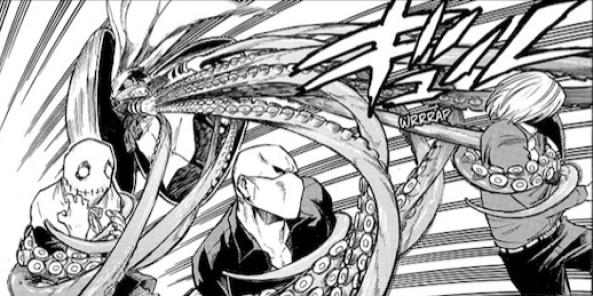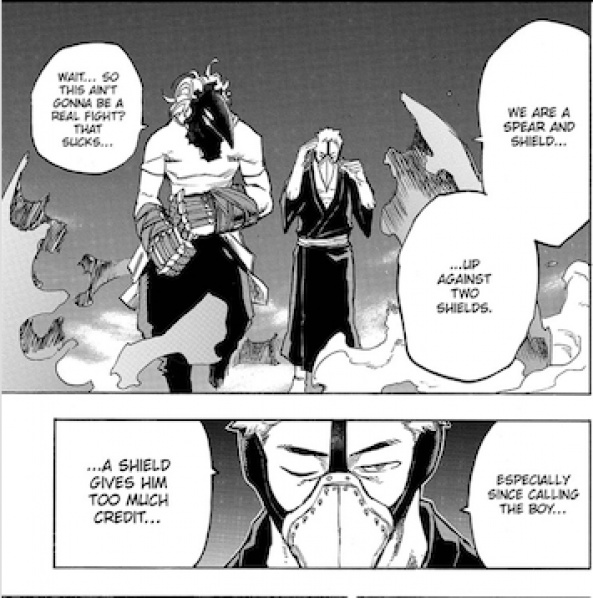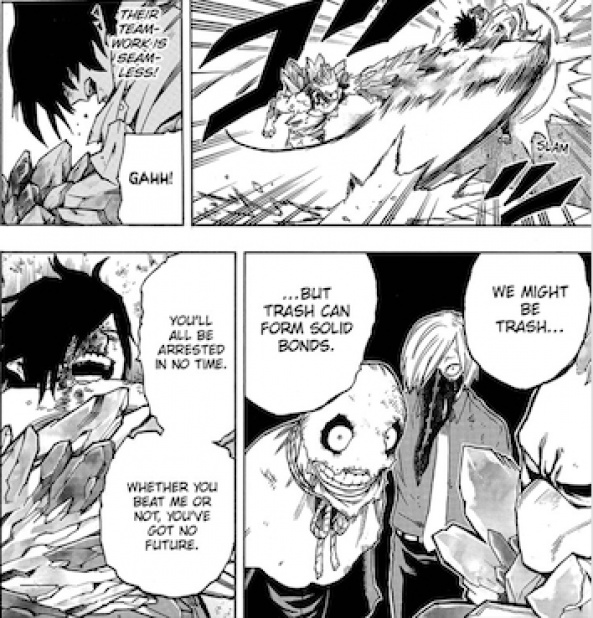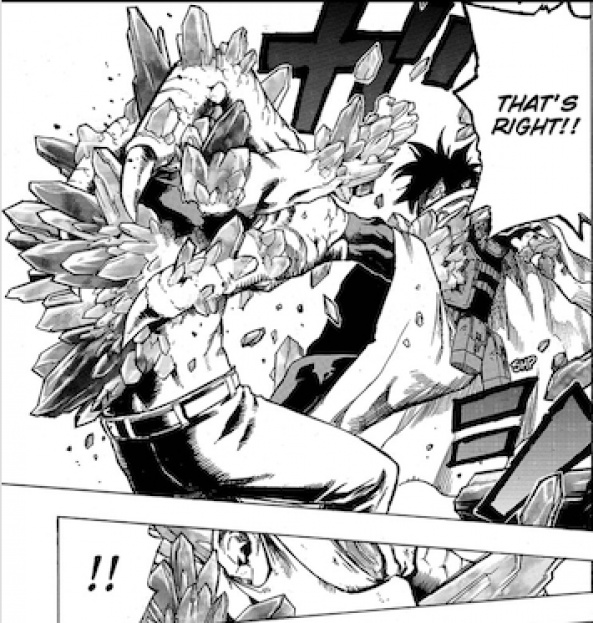Unfortunately, due to another unforeseen illness for the mangaka and subsequent one-week hiatus, there are only three chapters (numbered 141 through 143) to discuss this month, in comparison to last month’s five.
On the surface, these chapters simply earmark the end of one fight (between Tamaki “Suneater” Amajiki and three of the Hassai group’s Eight Bullets, named Setsuno, Hojo and Tabe) and the start of another (between Fat Gum and Eijirou “Red Riot” Kirishima, and two of the Hassai group’s Eight Bullets; Rappa and Tengai). However, by looking a little closer at these chapters, there are undoubtedly elements that ignite the possibility for a number of intriguing discussions.


One such topic that will be the focus of this month’s analysis, inspired by the resolution of a specific fight in the most recent collection of chapters, is Horikoshi’s approach to ‘The Power of Friendship’; a trope commonly associated with some shōnen manga. One such series, that is known to rely heavily on this premise when looking to resolve conflicts between their characters, is Hiro Mashima’s ‘Fairy Tail’.
The majority of series that often resort to using ‘The Power of Friendship’, as a vehicle to enable their protagonists to overcome the odds and snatch a victory from the jaws of defeat (‘Fairy Tail’ included), are doing so as a means to overcome both an inadequately structured narrative and badly scaled power levels. These are primarily stories that value style over substance, and as such, as the plot progresses, the mangaka introduces increasingly flashy and (often unreasonably) powerful villains who possess less of a personal stake in the world. This trend, coupled with the lacklustre progression of the protagonist (or more likely, the ensemble cast of protagonists), regularly leads to a showdown of little emotional impact between the heroes of the story and the arc/story-appropriate villain (either in isolation, or alongside an antagonistic cohort); in which the force for good cannot feasibly emerge triumphantly.
Because of this lack of forethought and effective planning, ‘The Power of Friendship’ trope is then wheeled out and utilised, as a simple way of explaining an outcome that cannot be reached by conventional methods (despite sometimes even defying the established laws of the narrative, in the process). When a mangaka takes such an approach with their story, it understandably leads to a largely negative outcry from many who have invested both time and money into supporting the series. This isn’t to say though that motivation derived from interpersonal relationships, is a stain on creative integrity in the realm of manga.
When handled well, actions driven by the bonds between well-developed characters can actually invoke unparalleled emotion in an audience. Yet the problem with ‘The Power of Friendship’ is that the emotional links it underlines do not encourage the relevant character to seek a solution, which conforms to any notion of sense in the established universe. Instead, ‘The Power of Friendship’ itself functions as a tool that grants victory. Thus the struggle is minimal, the bonds of friendship are exploited rather than developed, and an unsatisfactory climax is reached (either to a story arc or perhaps more shockingly in some cases, to the end of the story as a whole).
Therefore the existence of unreasonable conclusions to conflict (across a range of series), built upon hopeful foundations spanning significant periods of time, have arguably led to an atmosphere of apprehension and mistrust in the shōnen community. And that is why, when a series creator like Kōhei Horikoshi goes above and beyond to transform such ingrained ideas, I believe it should be recognised, and the literary subversion given the appropriate level of appreciation.
The fight in question, wherein Horikoshi tackles this contrived menace, features Tamaki “Suneater” Amajiki (a member of U.A. High’s Big Three) and three members of the Hassai group’s Eight Bullets. This conflict began in last month’s selection of chapters, but is concluded in the first of this month’s collection, with Chapter 141 – ‘Hassai Gang: Behind’. Prior to this point, Suneater has been established as a third-year student of heroics with a strong quirk (‘Manifest’ – meaning he can manifest parts of whatever he eats) and immense talent (with his mentor, Fat Gum, labelling him as the most capable hero amongst the group that was led astray by Irinaka’s ‘Mimicry’ quirk), despite his self-confidence issues. And so, with the words of his friend and classmate (Mirio “Lemillion” Togata) at the front of his mind – the same man who gave him his hero name – Suneater temporarily cast aside his insecurity and declared that he would remain and keep the three Bullets occupied. With such a set-up, it is made fairly clear to the audience that the heroic Suneater is expected to triumph, regardless of the numerical advantage that the villains possess. And although this fairly predictable outcome is indeed reached by the end of Chapter 141, the path that Horikoshi leads the characters down to arrive at this conclusion is incredibly entertaining, due to its take on the previously discussed trope of ‘The Power of Friendship’.
Continued below
Given the apparent power gap between Suneater and his three opponents, Horikoshi dials up the intrigue for this conflict by harnessing the camaraderie between the three villains. Their trust in one another (built upon a mutual understanding of them each being labelled as societal trash), and their willingness to cooperate in order to achieve victory (which in this circumstance, is done as a way to appease their saviour; Overhaul) is structurally reminiscent of numerous groups of protagonists in shōnen that rely on ‘The Power of Friendship’ to overcome any and all obstacles. It would perhaps have been more typical for the genre, had Horikoshi crafted the individual personalities of Setsuno, Hojo, and Tabe to be abrasive and ultimately self-defeating.

Yet in opposition to this norm, the three Bullets’ combat ability appears to be completely reliant on teamwork. Whether it was Setsuno creating an opportunity for Hojo to land a hit on Suneater, or Setsuno utilising his quirk to stop Tabe from being paralysed: every action the three Bullets took to defeat Suneater appeared to be coordinated and was executed seamlessly for the majority of the fight (as is noted by Suneater’s internal dialogue). This scenario allows for a balanced struggle between the villains and the young hero-in-training, built upon a solid foundation of creative quirk usage and acutely tactical decisions, rife with natural tension and genuine concern for the well-being of the protagonist of the moment.
However, the true genius of Horikoshi’s subverted execution of this trope is the fact that while the villain group’s teamwork enables them to close the power gap and engage Suneater in a close contest, it is that same element that Suneater manages to exploit as he claims victory over his villainous opponents. So not only does Horikoshi utilise ‘The Power of Friendship’ trope perfectly (in an inverted manner) by drawing on the similar tragic life experiences that the three Bullets share and crafting those bonds into a fighting style that can push one of U.A. High’s Big Three to his limit, Horikoshi undermines this same trope by proving that even in the hands of villains, friendship shouldn’t be enough to win the day.
In Chapter 141, the issue of relying solely on team-based attacks and trust in one’s allies is exposed by Suneater in two consecutive ways; ultimately ending in the downfall of the three Bullets. The first of these is Hojo and Tabe’s reliance on Setsuno, as prior to this point, he has given them both opportunities to act by stripping away Suneater’s defenses with his quirk (‘Larceny’). By obscuring his vision momentarily, Suneater managed to disable Setsuno’s quirk, and thus, the groundwork for their cohesion. This enabled the Big Three member to counter Hojo’s attack by manifesting his own crystals (after having ingested some during a prior clash with the bald villain), thereby granting him a chance to retaliate with a chicken’s foot (coated with crystals and supported by chunks of muscle and octopus tentacles in his leg as he had utilised, in his arm, in the beginning of the same chapter) large enough to grab the bulky Bullet.

Suneater then proceeded to take advantage of the group’s close ties to an even greater degree, by using the fully crystallised Hojo as a battering ram to incapacitate his fellow Bullets. This plan of attack was actually possible because of Tabe’s hesitation, as while Tabe’s quirk (‘Food’) and accompanying insatiable appetite would allow him to get to Suneater by eating right through Hojo – thus potentially putting an end to both the fight, and the teenage hero – Suneater knew that their earlier reliance on one another demonstrated a bond that Tabe himself would not be willing to sever so savagely.

And so, in the most recent chapters of ‘My Hero Academia’, Kōhei Horikoshi has managed to undoubtedly craft an engaging encounter between a relatively new heroic figure, and a trio of brand-new subordinates to a more established villainous figure, with aplomb. I believe this feat, carried out while concurrently addressing the shortcomings of a much-maligned (yet unfortunately prevalent) shōnen trope – ‘The Power of Friendship’ – deserves to be both recognised and praised. As such, I truly hope my contemplations, collated in this analysis, will lead you to do exactly that.
Beyond that though, I look forward to seeing how Horikoshi handles the rest of this current story arc. As ever, it looks to be an exciting and engaging experience, which once again speaks volumes about Horikoshi’s talent as a mangaka. Moving forward, I am intrigued to see: the conclusion of Fat Gum and Red Riot’s rumble with Rappa and Tengai, what has transpired with Ryukyu and the current members of her hero agency (eg. Uravity, Froppy and Nejire-chan), and how both Deku’s group and the isolated Lemillion go about completing their objective in the Shie Hassaikai compound. Therefore I hope you’ll join me next month, for another installment of ‘Go Beyond’, to see just how much of these exciting prospects have been touched upon.






